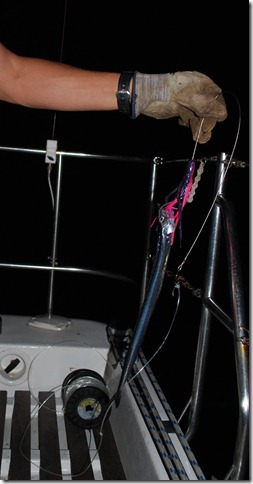Lat: 12 05.513′ S
Lon: 96 53.001′ E
After a couple of days offshore, things started to improve, at least for me. Lauren has a bit of an iron stomach so she was doing fine, but it took me a couple of days to liven up. The wind eased a bit, the motion of the boat seemed to get a little better, and I started feeling like I had my sea legs. I’ve also found that getting up at 3am to start watch requires an extra meal to keep feeling well. Seasickness and hunger feel pretty much the same offshore, and with my metabolism, a steady stream of calories is important.
The night before last was actually a pretty big milestone for us. We crossed halfway around the world as measured by longitude. We’re actually on the opposite side of the planet (about 100 deg E) from where we started (about 80 deg W). Even with the six month stop in New Zealand, it’s hard to believe that it’s taken us 18 months to get this far, and we’re trying to do the remaining half in 7 months or so. I guess we’re going to get used to being on the move. Like crossing the equator last year, this milestone happened in the middle of the night, so there wasn’t much of a celebration, but maybe we can remedy that tonight.
We were still getting waves of at least 10 feet, but yesterday things felt calm enough to put out a line. After being inspired by Colin “The Big Tuna” Murphy (as well as picking up a few cleaning tips by watching) during his visit from Fiji to Cairns, we decided we liked fishing. We’d lost enough tackle along the way, however, that we had to restock in Christmas Island. The guy in the shop there was great and set us up with everything we needed for several handline rigs. Yesterday afternoon I rigged a pink and purple octopus and we started trolling it while I read the Bible of fishing for cruisers, “The Cruiser’s Handbook of Fishing” by Scott & Wendy Bannerot. This came highly recommended to us and we managed to find a copy in Tonga, but haven’t made much use of it so far. I’ve now made it through the first couple of chapters, and it is pretty impressive in terms of how complete and well-tailored it is to the cruiser. I pulled the line in at sunset and felt some extra drag. It turned out to be what looked like a juvenile wahoo, long, but skinny enough to be a trumpet fish, so we tossed it back.
This morning I had two lines in the water by 8 am. I don’t really eat much fish, but I was really hoping to catch something for Lauren to enjoy and possibly to share at the Direction Island BBQs that Cocos is well known for among the sailing community. Around 9 am we were only about 4 miles from the pass and the port line was taut. I woke Lauren up and about 5 minutes later I gaffed and dispatched a 2.5 foot wahoo. It’s our first wahoo and our first edible fish in general sans Colin. We’ve had so much electrical power from the two wind generators running during the blow that we had on the way here that we’ve been running the freezer at least 12 hours a day just to drain some power even though we don’t really have anything to put in it. Now we do. Lauren finished filleting the wahoo just after we came in through the pass and even with our rookie cleaning abilities, she estimates that we have 7-8 servings.
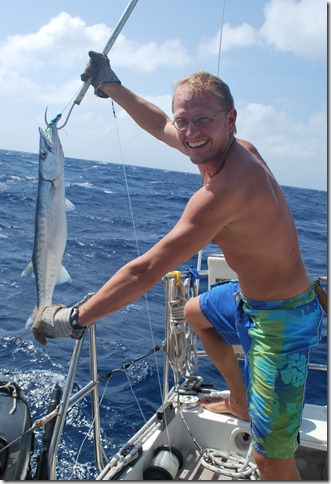 We learned later that it’s actually a barracuda, but it’s good eating
We learned later that it’s actually a barracuda, but it’s good eating
Cocos (Keeling) Island is actually two “islands”, North Cocos and South Cocos. North doesn’t really have an anchorage and is uninhabited. South Cocos is an atoll, but with much, much larger passes than any of the atolls in the Tuamotus. The small islets ringing the lagoon are called islands instead of motus, but other than that, it’s your typical atoll. We’re anchored in the yacht anchorage in the NE portion of the lagoon behind Direction Island. Waiting here in the anchorage were S/V Bahati (US yacht) and S/V Josephine II (Australian), both of which we’d met briefly at Christmas. Bahati gave us some help over the radio to find our way into the inner lagoon and we dropped anchor in crystal clear water. Cocos is reputed to be one of the more beautiful spots in the world and although we still haven’t found an ugly atoll or tropical island, it is definitely picturesque, with white sandy beaches, plenty of coconut palms, white crashing waves, and many shades of blue and turquoise scattered throughout the lagoon.
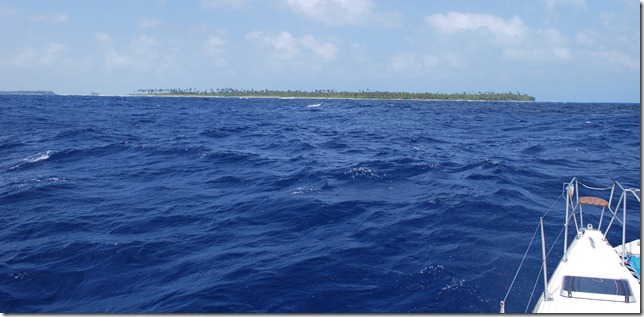 It’s been a long time since we’ve made landfall at an atoll. This will probably be our last one as well.
It’s been a long time since we’ve made landfall at an atoll. This will probably be our last one as well.
We hadn’t even turned off the engine when our greeting committee arrived — 6 black-tip reef sharks. I don’t know whether it was the fish blood dripping down the cockpit drain (I’d dumped 3 buckets of seawater over the grate and scrubbed it offshore) or just us being the new arrival, but they’ve stuck around. I guess there won’t be any falling in the water here, although Bahati says they’re shy and get scared off when you jump in. There were a couple of flying fish on deck and tossing those and a bucket of sea water that had been used to rinse the wahoo filets caused a bit of a stir. Suddenly there were 8-10 sharks and they became a bit frenzied, swimming in tight circles and swinging their heads back and forth until one of them inhaled the flying fish and the fishy water dissipated.
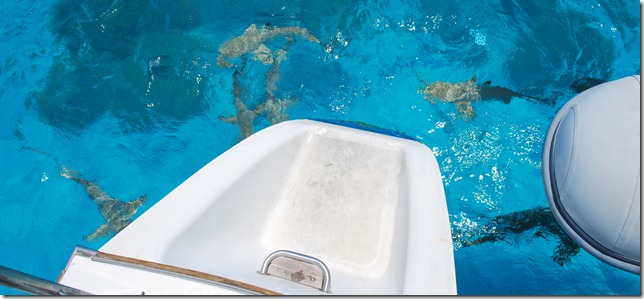 Half a dozen members of the welcoming committee
Half a dozen members of the welcoming committee
We were expecting to have customs visit the boat, but the Australian Federal Police, who handle customs, immigration, and quarantine here asked us to dinghy over to Home Island to meet them at their office. That wasn’t what I wanted to hear. The outboard hasn’t been too reliable because the carb really needed a cleaning, we don’t have a lot of gasoline, and what we do have is a little suspect. Cedric actually pulled a fair amount of water out of the outboard fuel tank (which may explain the dirty carb) while we were in Perth. Home Island, the main settlement for the descendants of the Malay workers originally brought here to work the copra plantation is about a 2 mile dinghy ride and West Island, the main Australian settlement is a long ferry ride from Home Island. The outboard had been doing well at high RPMs, which made me think the pilot jet was clogged but the main jet was fine. It seems to have started out that way, but we didn’t make it far before the engine wouldn’t do anything but idle and then it didn’t even want to idle. We started paddling toward a nearby, upwind buoy, but paddling even 30 feet into the blustery tradewinds was hard work and pretty slow going. Anticipating potential problems, I had stocked the dinghy with what we might need (anchor, tools to remove and disassemble the carb, radio, PLB, etc.), but luckily Stephen on Josephine saw us struggling and came out in their dinghy to tow us back.
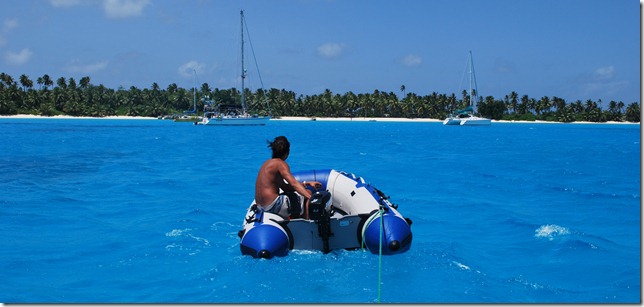 Stephen giving us a tow in paradise
Stephen giving us a tow in paradise
An hour or two later, the incredibly dirty carb was cleaned, the fuel and been checked and separated from the small amount of remaining water and sediment, and we’d both had a bite to eat. This time the only adventure on the way to Home Island was the chop whipped up by the tradewinds. We were motoring into it (for 2 miles) and we were both soaked from the waist down and on the windward side of our upper body as well by time we tied up to the wharf. Our timing was perfect. We split up immediately and managed to check in, check out (we’re planning to leave on Saturday), pay shire fees (they want $10/day just to anchor here), fill water jugs, pick up some fresh fruit and veggies and leave about 30 minutes later with all of the stores and offices we’d visited having just closed. Everybody was incredibly friendly, and even though we don’t expect to make a second visit, it’s clearly another place that would be nice to stay a while if we weren’t up against the start of the cyclone season.
We didn’t know for sure who else would be heading toward South Africa with us this year, but in addition to the World ARC, which we’re mostly trying to avoid, we identified several other boats, including one that is taking the same route that we’re planning, over the north tip of Madagascar. That boat is a single-hander that’s only 500 miles or so away from Madagascar, but we’re expecting to be able to contact him and the others on a twice-daily HF radio sked that we learned about today from Bahati. We were happy to hear that there’s someone ahead of us that we can pick up some tips from and that there will be some familiar voices out there during our long passage.
That’s all for now. We’re anchored in a beautiful lagoon, have fresh wahoo to BBQ, have cold Bintang in the freezer, just enjoyed a nice shower, get to sleep all night, and are getting ready to enjoy the sunset. Ahhh.
Lat: 11 16.408′ S
Long: 102 38.144′ E
We enjoyed the rest of our time at Christmas Island and wish we could have had more. We didn’t have a chance to rent a car and see the sights that are well known on the island such as the millions of red crabs that live in the forest and block the roads during the migration to the beach for egg laying. They also have Robber Crabs here, just like the blue Coconut crabs in the Pacific except larger and more plentiful since they are protected. Peter, one of the night nurses at the hospital, showed us some impressive pictures that he’d taken of crabs, waterfalls, and other sights around the island, so at least we were exposed to them that way.
We spent most of our last days on the island taking care of business, but we also had a chance to distribute homemade cookies to our new friends on the island (No-Bake Oatmeal Truffle cookies are good to make on a hot boat), eat dinner aboard Marionette, and get back in the water. Dallas used the dive gear to assist Markus in taking a look at his keel and took him on a quick dive below his boat. Meanwhile I went for a short snorkel and managed to see some really good stuff — a small green turtle, a poisonous lionfish (it looks like it has feathers shooting out from each side of its very slender black and white body), and a fish that was so intensely bright blue against a backdrop of muted pastel coral that it seemed like it was not supposed to be there. Apparently the coral is not as vibrant as it used to be there in the cove, but that’s hard to imagine. Along the edge near the wall of coral that runs around the west side of the cove, the bottom is totally covered with coral fans, brain coral, antler coral, etc.
As far as my recovery, I’m not quite 100%, but I’m getting there. I can eat soft foods now, which opens up many more options to please my variety-loving palate, but I still don’t have the energy or strength that I’m used to having. It doesn’t seem to affect my ability to sail too much, although I must admit that I haven’t been a very good cheerleader on this passage. We’ve had strong winds, big seas, and squalls right from the start. We’re flying along at over 6 knots using just the jib. It’s pretty rough compared to what we are used to here in the tropics — at times it feels like we’re getting tossed around like a mouse in the paws of a big cat. Not to mention that, as Dallas said, all of the time we’ve been spending on land lately has made us “soft”. Yesterday was the worst, as first days at sea usually are, but with this being the first leg of a very long passage to Madagascar, it seemed particularly overwhelming.
At the marine museum in Fremantle, we watched an interview with Jon Sanders, the Aussie who circumnavigated three times non-stop, spending over 600 consecutive days at sea. When asked how he handled it mentally, he stated that he did not allow himself to think negatively, he just focused on the next milestone. Well, neither Dallas, who’s feeling a bit sick from all the motion, nor me were too enthusiastic yesterday, but we didn’t get too negative (Ok, I was borderline) and are having a much better time of it today. We just finished a nice dinner of salad and alfredo pasta and listened to some international news on the SSB radio. We’ve also changed course to get on the rhumb line to Cocos Keeling Island and now have the seas on our stern quarter rather than the beam, which is more comfortable. The rain has eased up, and it’s looking like it might be a relatively clear night.


